They have 1.25+ million paid users. Their trial to paid conversion rate is sitting at 30%.
There’s just no better way to put it: Slack is absolutely kickin’ ass in the SaaS world.
But they don’t need me to tell the world how well they’re doing. Just look at their stats:
- They are the fastest growing SaaS company. Of all time.
- They have gone from being valued at $0 to $4 BILLION. In just 4 years.
- They are adding $1 million in new contracts. Every. 11. Days.
- They have 77% of the Fortune 100 using their software.
- They have 4 million active daily users.

Growth chart for Slack’s active daily users [Source]
Oh, and did I mention they did ALL of this without a million-dollar marketing technique, a fancy email strategy, or a pushy outbound sales team?
Actually, it wasn’t until recently that Slack even bothered hiring salespeople and they managed to become a $1.1 billion company before bringing on a CMO.
So, how did Slack actually do it?
Let’s find out.
Navigate this Post
Overview of Slack’s Strategy
Before we talk about Slack’s overall strategy, we first have to talk about its astonishing initial growth.

A tweet by Marc Andreessen on Feb 10, 2014 [Source]
Most of Slack’s initial growth was thanks to word-of-mouth marketing (and actually, even today this continues to be Slack’s #1 priority).
The initial word-of-mouth spread is partially attributed to Slack’s famous founder, Stewart Butterfield and partially attributed to Slack’s amazing product-market fit.
Before Slack, Butterfield was well-known as the founder of the photo sharing platform Flickr that was acquired by Yahoo! in March, 2005.
As expected, Butterfield (and the core team largely drawn from the founders that created Flickr) had the benefit of a lot of contacts, including those in the media, that they could leverage to get the word out. These connections obviously paid off – 8,000 people signed up on Slack’s very first day and two weeks later, that number had almost doubled.
Interestingly, Butterfield launched one project before Slack (a computer game called Glitch) which launched in September 2011 but closed down just over a year later in November 2012 due to not being able to attract an audience large enough to sustain itself.
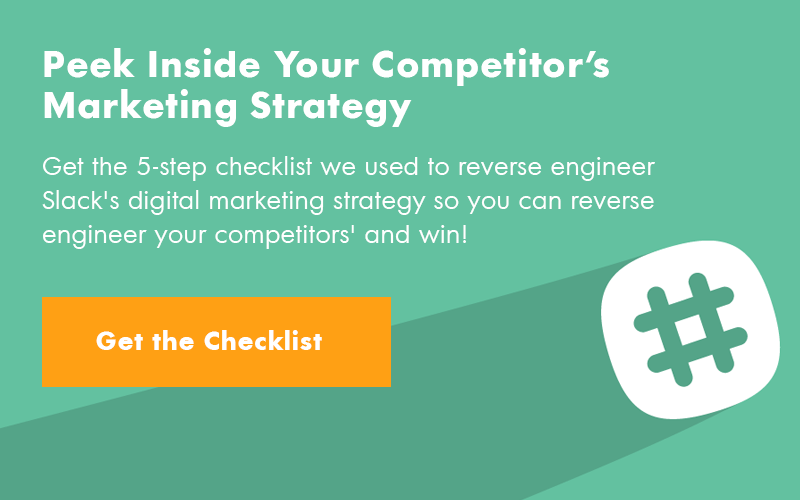
This is living proof that no matter how good your connections are and how great your product is, if it doesn’t meet the needs of the market, it will fail.
Butterfield learnt from his failure and his second project (Slack) found product-market fit instantly. Slack now continues to rely heavily on word-of-mouth marketing and on brand building to generate organic views to their website.
They focus heavily on a few core marketing channels, such as social media and a Medium publication, that help them continually get their name out there. Plus, they’ve managed to define a distinctive brand voice that is personal, memorable, and entertaining.
But to amplify this organic traction, more recently, they’ve ramped their PPC advertising.
Traffic Profile for Slack.com

The above image shows Slack’s public facing main site. As you can see, the majority of Slack’s traffic comes from direct sources…meaning 91.35% of those 108.6 million monthly visitors are going to the website directly (BTW: 108M+ monthly visitors is 5x HubSpot’s 20M+).
But given that Slack has 4+ million daily active users, a very high percentage of this traffic is likely users heading to the website to login into the app.
This high amount of direct traffic can also be attributed to that ultra-powerful word-of-mouth awareness that Slack has worked so hard to achieve. In other words, since so many people already know Slack by name, they just type Slack.com directly into the browser.
Beyond the direct traffic, there are a few other tricks of the trade that Slack is using to get organic traffic – organic search and referrals.
Top Performing Organic Traffic
Based on Slack’s organic search results, they have 638 keywords that rank on the first page of Google, and 345 that rank on the first page of Bing/Yahoo!.
This number of first page ranking keywords is significantly lower than what you find with many other high-performing SaaS companies. When I analyzed HubSpot here, for example, I found that HubSpot has an impressive 5,905 first page keywords on Google and 10,440 on Bing/Yahoo!.
But there’s a pretty easy answer for this disparity. Unlike HubSpot, which puts a lot of effort into building up their SEO through content marketing, Slack has adopted different methods.
So while HubSpot will show up for search phrases like “how to use Excel” because they wrote a blog post on the topic, Slack hasn’t created any content marketing articles for the express purpose of SEO and organic traffic.
Instead, a big part of Slack’s organic SEO success comes from Slack’s App Directory landing pages.
Here is a table that’ll give you an idea of how this works. It’s an overview of some of Slack’s top organic keywords with the highest global monthly search volume by rank on the first page of Google. All the organic listing links drive traffic to one of Slack’s App Directory landing pages.
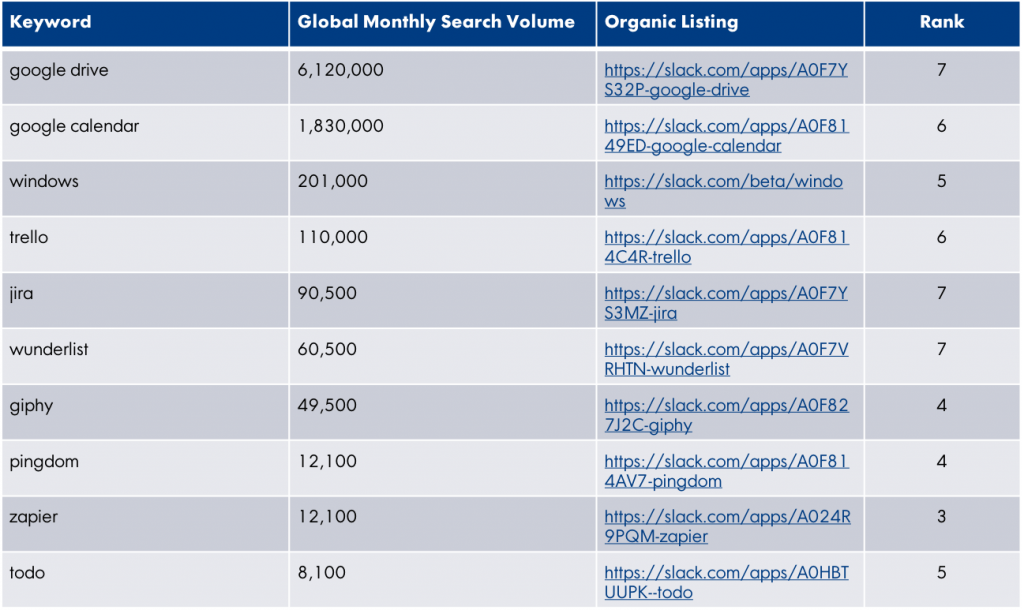
As you can see here quite obviously, the people who type in these keywords aren’t specifically searching for Slack. Yet, people who search for these other products often see Slack’s website. Why?
Well, the first thing to note is that each and every one of these are products that have integration capabilities with Slack. So, Slack took advantage of this to make sure they often end up on the first page search results whenever anyone searches a product with which Slack integrates.
To do this, Slack has an individual landing page for each of their integrations. Some are created by App Directory Partners, while major integrations are often created by Slack themself.
For Slack created integration webpages, each webpage follows the same simple 3-part sequence for their SEO strategy:
- The name of the integration in the webpage’s headline
- One sentence explaining what the integration is
- One sentence explaining how the integration works with Slack
Here’s an example of what this looks like for the integration with Pingdom:
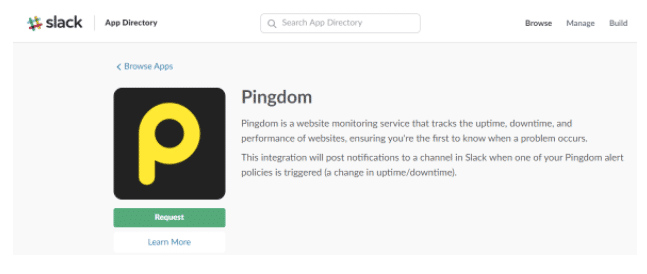
Take note, the smart folks over at Slack know that having an App Directory is critical to their long term success. Why? Because the more integrations people add to their Slack, the more “sticky” they will become as their entire working life becomes fully integrated with Slack.
Slack literally becomes (as their slogan so aptly describes) “Where work happens.”
Though Slack’s “integration page SEO” keywords are obviously very powerful for SEO and product stickiness, here are the keywords that really bring the most amount of traffic to Slack:

What sticks out to you? The word ‘Slack’ shows up in every single one!
Even the fifth organic keyword is just the word “Slack” in Japanese. Japan is Slack’s biggest market outside the United States (see proof below).

Slack’s traffic profile by country
Slack’s other top keywords, beyond the branded ones, usually relate directly to their product offering (ie: messaging, team communication, etc).
This all goes back to Slack’s awesome word-of-mouth brand awareness. Because of it, Slack doesn’t need to put huge amounts of focus on content marketing or their SEO – their brand name and product offerings do a lot of the work for them.
Top Performing Referral Traffic
Now let’s take a look at Slack’s referral traffic. Referrals make up 3.34% of Slack’s total traffic, and here are Slack’s top 5 referrers:

Of all these referrers, the second and third are the most interesting: GitHub and Trello.
As we just discussed above, Slack has a ton of integrations. And two of these are – you guessed it – GitHub and Trello.
If I click on the GitHub link in that referral image above, I end up on a GitHub page explaining how Slack and GitHub can be integrated.

And if I click the Trello link, I end up on a similar integration page on Trello’s website:
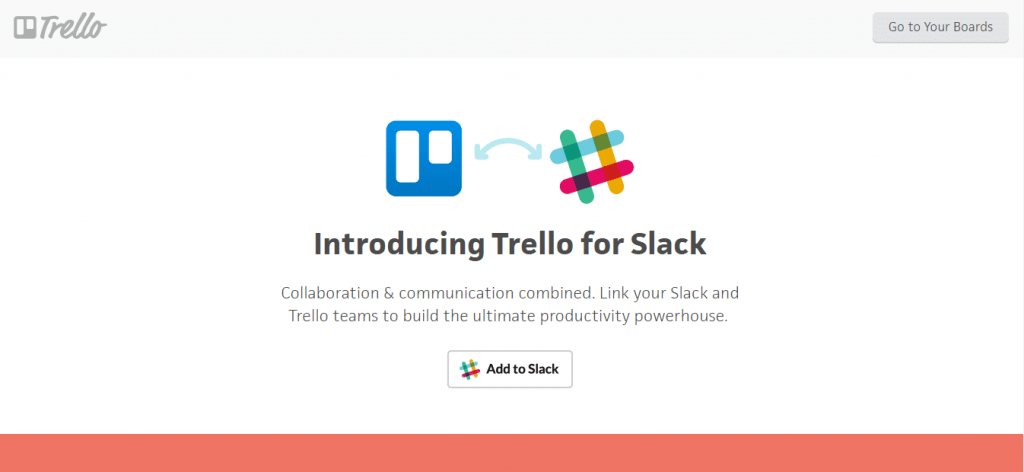
At first glance, it might not seem like the clicks from these two referrals are all that significant. After all, combining these GitHub and Trello pages only account for 9.84% of all referral traffic, and referral traffic only brings 3.34% of Slack’s total traffic.
But even though these percentages may seem small, you first need to take into account the sheer number of visitors to Slack every month (108.6 million!).
And if you consider the percentages above out of Slack’s total monthly visitors, the numbers actually look pretty good. GitHub alone brings Slack approximately 200,000+ clicks monthly and Trello brings them 150,000+. Not bad for something Slack doesn’t really have to do much for.
Slack’s not the first company to accelerate growth via integrations. One strategic integration is part of what helped YouTube get so big, so fast.
Back when YouTube first began in 2005 as an unknown company, they integrated with MySpace, thus tapping into the 25 million unique users MySpace had at the time, without having to seek these visitors out themself.
Essentially, integrations let you piggyback off the success of another platform.
Slack has 1,000+ integrations (231 alone just in Bots apps) – meaning they are reaping A LOT of benefits and extra traffic because of them.
And of course, the fourth referrer is Slack’s Medium publication. Their Medium publication brings an extra 76,063 interested visitors to their main site every month.
On that note, let’s move on to analyzing Slack’s Medium publication.
Traffic Profile for SlackHQ.com (Slack’s Medium Publication)

SlackHQ.com, also called Several People Are Typing – The Official Slack Blog is Slack’s Medium publication. As you can see, the traffic sources here are quite different from their main website.
After direct traffic, the second largest driver is search clocking in at 11.45%. If you look at the organic search terms below, you can see that the top keywords are all branded.

When you approach Slack’s main page, the link to the blog isn’t very obvious:

This accounts for the high number of people searching for the phrase “slack blog” (after all, what kind of big business doesn’t have a blog?).
The middle 3 keyword phrases from their Top 5 Organic keywords above are customer search queries and questions about their product that Slack knew were common and thus decided to write articles on.
Here are the 3 specific pages generating that traffic on the SlackHQ Medium publication:
This gives Slack a clever way to provide customers with more product info without just referring them to a boring “help” page.
As far as referrers go, it’s interesting to note that not one of the top referrers is the Slack website itself. This is probably due to how discrete the blog link is on Slack’s main website.
On Slack’s main website they have strategically moved all distractions to their footer (blog, podcast, app directory, etc). This puts more focus on converting visitors into freemium users.

Over 50% of the referring traffic to Slack’s Medium publication comes from Medium itself, as Slack has a strong Medium presence with over 125,000 followers and is featured first on the Medium Brands page.
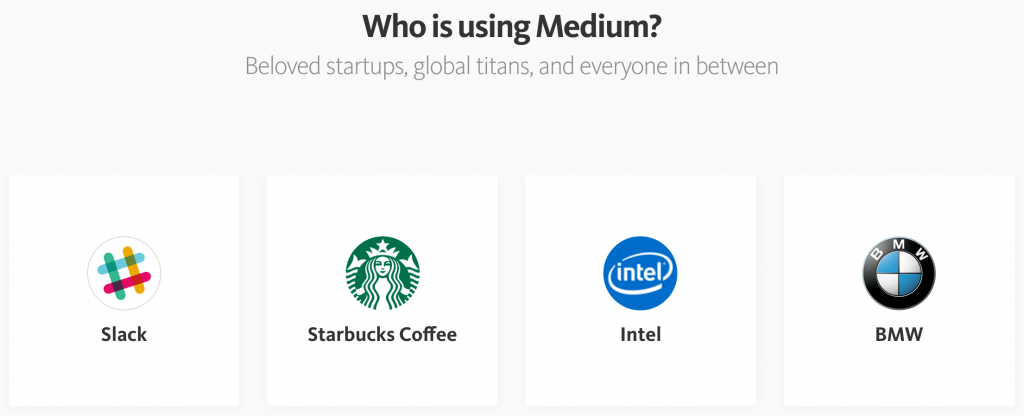
The page, pictured above, accounts for 7.27% of SlackHQ’s referral traffic, but where is that top 47.54% of Medium referral traffic actually coming from? Answer: Medium’s homepage in the ‘Popular On Medium’ section and the ‘Medium Daily Digest’ email.
By really finding their voice and tapping into the type of personal and real-life articles that perform well on Medium, Slack often find itself on Medium’s ‘Popular On Medium’ section or featured in the Daily Digest email that Medium sends to its subscribers.

How can you do the same?
Build your Medium following and publish articles that Medium’s algorithm loves (ie: high read ratio, high amount of recommends, high comment count, etc…basically everything that comes to you when you create really good content).
Part of Slack’s major success with Medium is that they already had a large audience to market to. In fact, back when they began their publication in August 2014 with an article titled “11 Useful Tips for Getting the Most of Slack,” it was recommended 1,024 times…even though it was their first article ever!

How did Slack manage to get this much engagement on their very first article? Well, one theory goes back to a feature that makes Medium an awesome marketing tool: it lets you bring your followers from another platform.
In other words, if you sign up with Medium through either Twitter or Facebook, Medium will automatically import all of your followers that already have a Medium account.
And as you’ll see in our social media analysis below, Twitter has been the backbone of a lot of Slack’s success and customer interaction. So, Slack probably leveraged this by signing up with Medium through their Twitter account to quickly reach their first 100,000 Medium followers.
Beyond Medium itself and Twitter, there is one last referrer (the fifth one) to SlackHQ that is worth talking about because companies don’t often realize its viral marketing potential: Hacker News.
People often post Slack’s articles there, opening them up to extra interest, views, and engagement. When this happens Hacker News can quickly jump to Slack’s #1 referral traffic source in any given month.

Top Performing Medium Articles
Slack’s Medium publication is a combination of product updates and tutorials, practical workplace tips, and personal stories.
This combination helps Slack:
- Generate an extra 70,000+ viewers to their main website monthly
- Keep their current customers in-the-know or encourage potential prospects with Slack updates and improvements
- Connect with their readers (whether they are already users or not) and continue building their brand name with their unique customer voice
As you’ve seen from the SlackHQ.com traffic profile above, Slack does quite well for itself on Medium (500,000+ monthly website visitors).
Here are the exact Medium posts that have done the best according to social engagement:
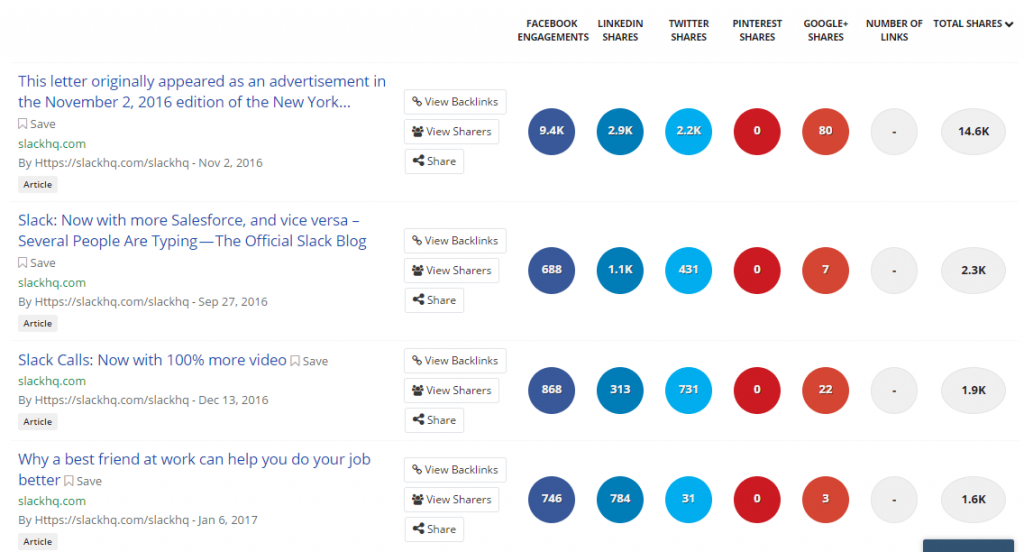
The top post is an excellent showcase of Slack’s distinctive, unique brand voice (but we’ll chat about this one in the “Top Performing Paid Traffic” section later in the article).
The middle two are articles about Slack product updates. Take note of how Slack demonstrates their awareness of the importance of their own brand name: each title actually begins with the word “Slack.”
The final top performer is a personal, relatable, story-based article written by an outside author.
The calls-to-action (CTAs) on most of Slack’s Medium articles are some variation of opening up a dialogue with their customers by asking them to reach out with questions or suggestions.

They also always link to their Twitter page in the CTA (you can see why in the screenshot below).
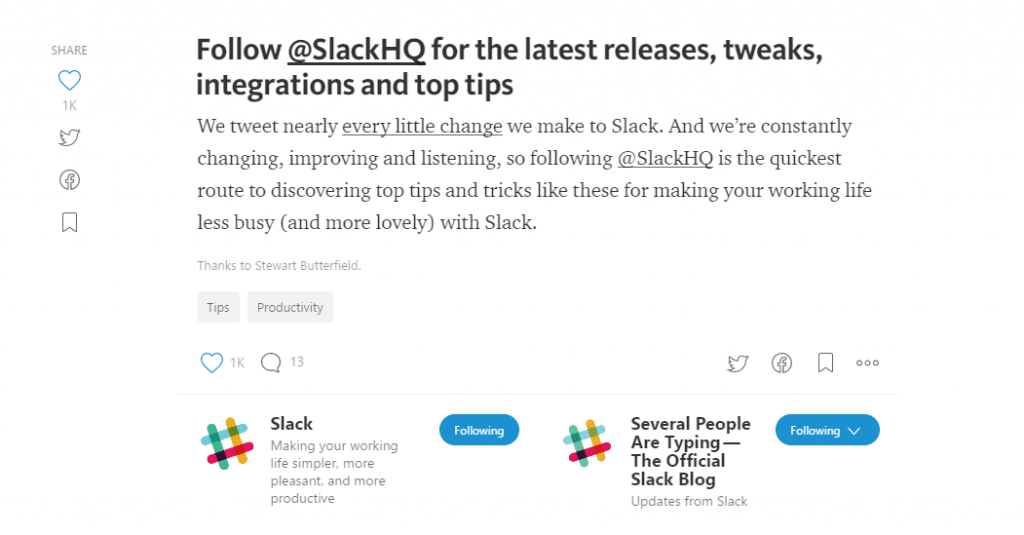
At the end of articles about product updates, the CTA often links readers to more product related information and gives a few links to other product updates they think their readers might like to know about.

For personal, story-based articles, there’s no CTA at all: just an image and blurb about the guest author.

One more thing to note is that Slack runs their blog solely on Medium and doesn’t have their own blog outside of it. More and more companies are doing this, finding Medium to be a great platform that can open them up to a whole new potential audience that they might not reach otherwise.
Top Performing Paid Traffic
Slack founder and CEO Stewart Butterfield has openly admitted that paid marketing hasn’t been his priority nor his main traffic driver for Slack.
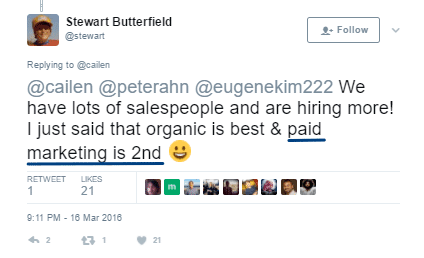
A tweet by Stewart Butterfield on Mar 16, 2016 [Source]
Yet, paid marketing still plays a pretty big role in Slack’s success, accounting for nearly 400,000 website views monthly.
These are the top performing ads for the 2,100 PPC keywords Slack is bidding on:

As you can see, every single one of these ads has the word “Slack” and the word “Team.”
Each headline also contains one of the following 3 words: “Communication,” “Collaboration,” or “Messaging.”
The ad copy varies between benefit-driven (ie: fewer meetings, less internal email, all your tools integrated) and feature-driven (ie: real time messaging, file sharing, and powerful search).
Clicking on any of the top performing ads will bring prospects to one of two places: Slack’s homepage or Slack’s product page.
Here’s the entire paid search funnel for ads that direct prospects to the product page:

As you can see, they are using a single landing page for a lot of different keywords. Usually, a company would create several different landing pages based on the searcher’s keyword intent, but this particular landing page must be working well enough for Slack that they can just direct all of them here. (Don’t worry, we’ll talk about why this is a good landing page in the upcoming “Landing Page Breakdown” section).
You can see that most of the keywords are some variation of “collaboration”, “messaging” or “communication.” Slack has the challenge (or the benefit, depending on how you look at it), of having to appeal to a wide audience. But clearly, Slack has found three words that seem to have universal appeal, no matter who’s searching.
You’ll also see that there are a few competitor branded keywords (ie: “office 365 instant messaging”).
As far as I could tell, Slack isn’t investing in retargeting ads. Per this discussion in 2015, they weren’t. And I haven’t found anything implying they are now:

A tweet by SlackHQ on Mar 19, 2015 [Source]
In general, it’s safe to say that Slack’s focus with their advertising has been more on brand building than anything else. This means they’ve also experimented with some more ‘traditional’ forms of advertising to help get their name out:

A tweet by a Slack Account Executive on May 22, 2017 [Source]
One of Slack’s most memorable ventures into traditional advertising happened when they took out a full-page ad in the New York Times.This ad served as a challenge to Microsoft, who was soon to launch their own competing product.

A tweet by Stewart Butterfield on Nov 2, 2016 [Source]
Slack then sensibly published the whole ad on their Medium publication, thus providing them yet another outlet to get their name out and spread the word. Clearly, it worked. If you look back to our analysis of their top performing Medium articles above, you’ll notice that this article snagged the top spot with 14,600 shares.
You can find the whole letter on Slack’s Medium publication here.
I can’t say for sure whether or not this ad brought more paying customers, but it sure got a lot of media attention and probably created some loyal fans.
Landing Page Breakdown
As mentioned above, Slack only has 2 landing pages that they currently use for their paid ads – either their homepage or their product page.
Most companies have many landing page options to cater to different audience members, search keywords, and product offerings. But since Slack caters to such a wide audience; gets traffic primarily through branded keywords, and only has a single product offering, they can get away with so few.
There’s not too much to say about the homepage, so let’s look at that first.

This is what a viewer will see above-the-fold if they end up on Slack’s homepage.
It’s short, sweet, and simple. There’s really not much to it: Slack’s motto, their unique selling proposition (USP), and a big green CTA calling on their audience to “Get Started.”
This is the page they direct people to who find them via branded keywords:
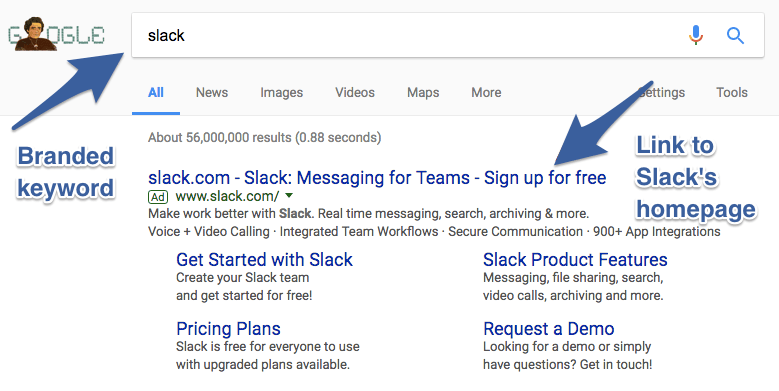
After all, if someone already knows enough about Slack to type their brand name directly into the search bar, you hardly need to overwhelm them with extra info or a full-fledged sales page. Really, all they need is an easy next step. In this case, clicking the “Get Started” button.
On the homepage, the audience can get a bit more info if they scroll down.

But by making this section (pictured above) not stand out, it prevents the reader from getting distracted and instantly draws their eyes to the CTA button as the only logical next step.
Beyond the homepage, Slack also uses their Product page as a landing page. Interestingly enough, this isn’t a special landing page that can only be found by clicking on a paid Slack ad. You can actually find it by clicking on the “Product” text link in their website footer or top navigation.
Though the Product page is certainly longer than the homepage, it is by no means text heavy; instead, it revolves around colorful and appealing visuals.
Let’s break down the page scroll-by-scroll to see what’s going on.
To start, here’s what the landing page looks like above-the-fold:
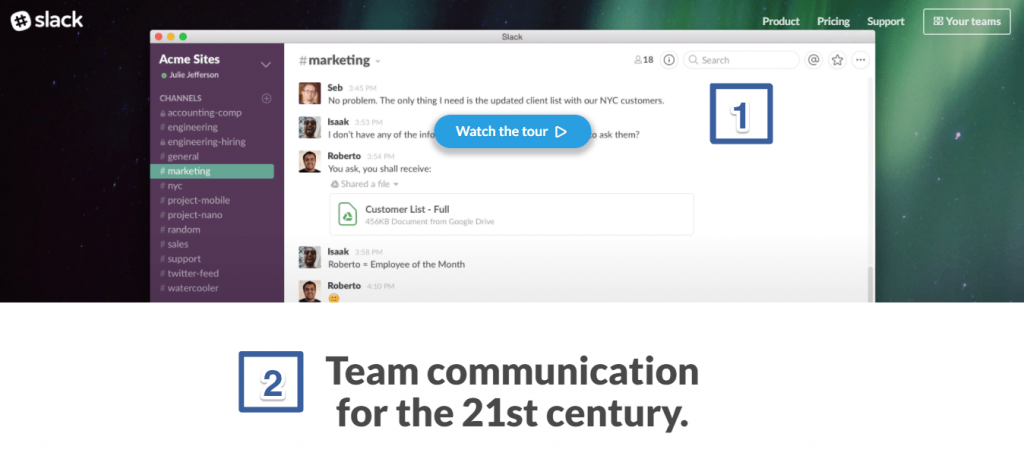
1. A prominently displayed video is the first thing a person sees. If I were to “Watch the tour,” I’d get an overview of Slack’s main benefits to see how it actually works.
2. A simple, concise description of what Slack offers. Bad team communication is a pretty universal pain point, so it’s good to give the audience a reminder of what Slack does early on.
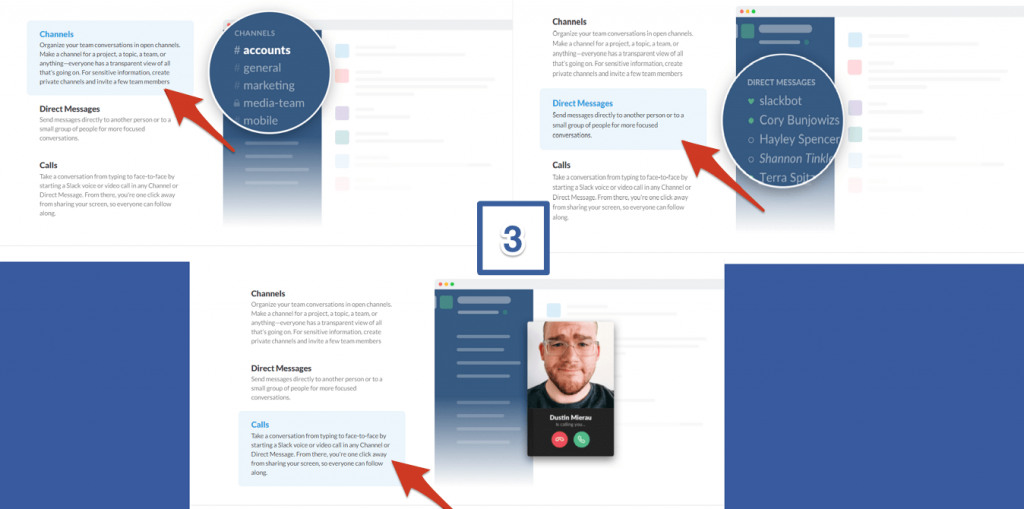
3. A quick breakdown of Slack’s 3 core features, where the right side of the page changes based on which arrowed section I click on above. The changing image is not only visually appealing, but also promotes more interaction with the page.
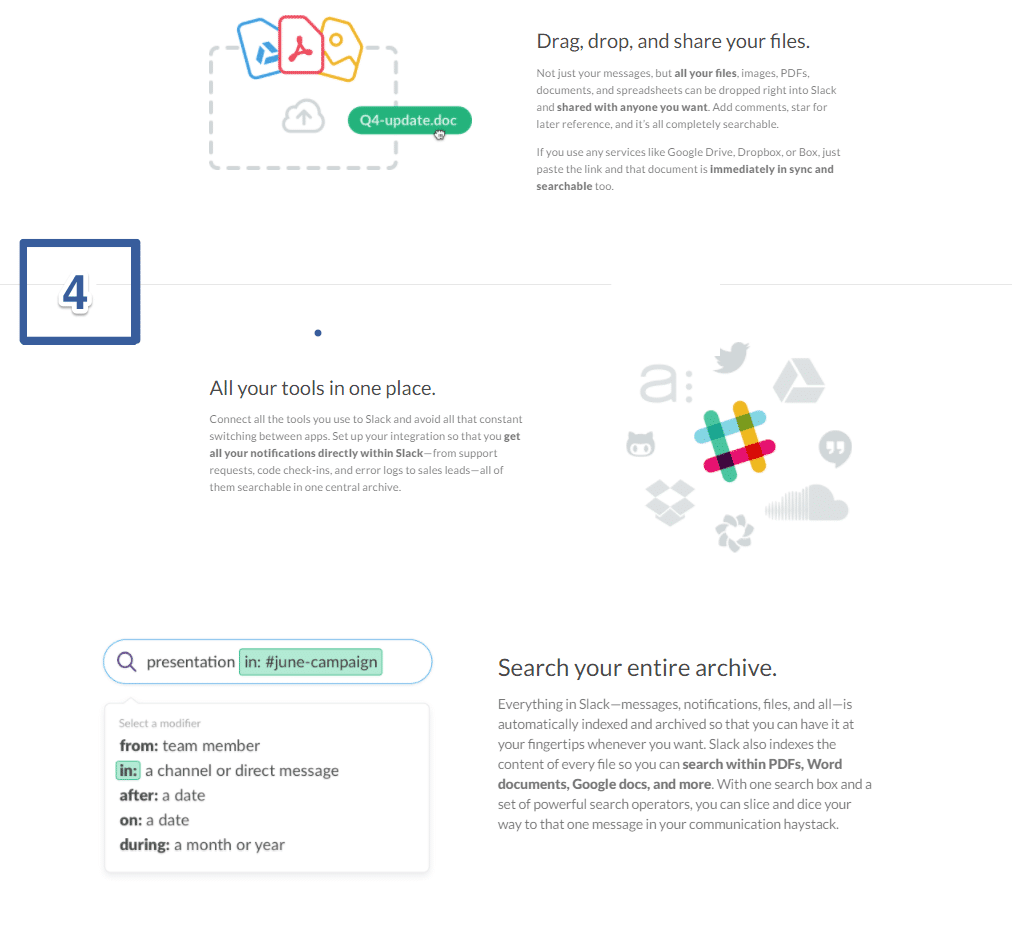
4. After reading about some of Slack’s features in #3, you’ll find the benefits in #4.
Now, you may be wondering why Slack discusses features, instead of benefits, first. Well, if you were to just look at Slack’s benefits above without any knowledge of what Slack does in the first place, would you be impressed? No! Likely, you’d just sit there scratching your head and asking what Slack even does.
But, by first making sure the audience actually understands what Slack is and what it does with the short feature descriptions and images in #3, the audience is able to fully appreciate the benefits of #4.
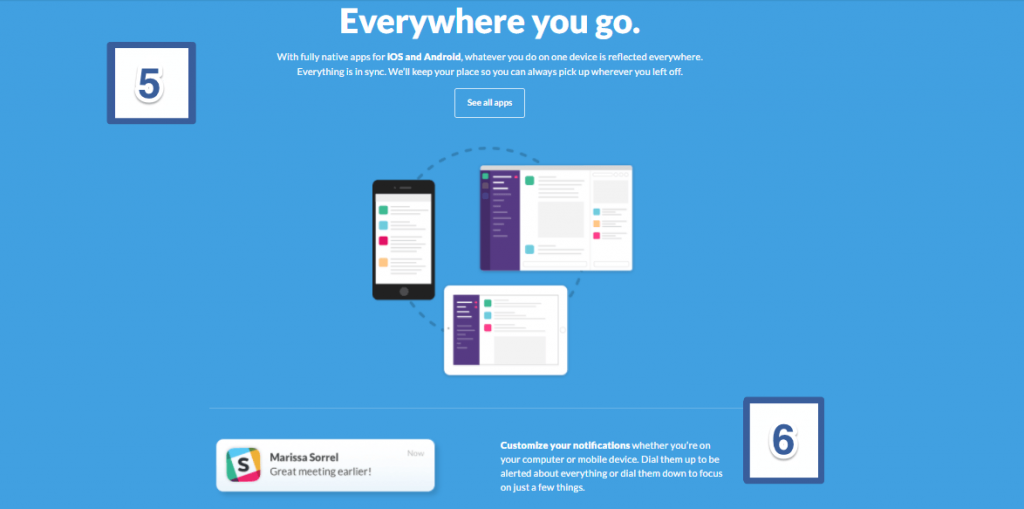
5. Another benefit. This time showing off Slack’s practicality and ease-of-use with fully native iOS and Android apps. No one likes transitioning to a new software or program, so making prospects feel like transitioning to Slack is an easy thing to do will help.
6. Overcoming a common objection. Slack let’s people know they can customize their notifications, to overcome a common objection people have of getting ‘too many annoying notifications’.

7. A section on the page to filter large enterprise leads to their Enterprise page.

8. Another benefit.
9. Addressing a major audience pain point (email) and backing up how Slack is the solution. They don’t just say they are the solution, though. They use a super-specific number that shows how big of a difference their product can actually make (48.6% reduction in internal email), thus lending credibility and building trust.
10. Instead of including testimonials or throwing a bunch of numbers at the prospect, Slack gives the prospect a bit more agency. In this case, the prospect has the opportunity to make their own decision about whether or not they want to “See the data.”
This is an interesting choice, considering that other companies often throw all their best ‘social proof’ right onto their landing page.

11. The landing page’s primary CTA. By highlighting the fact that Slack is free for life, what reason would a prospect have to not click the CTA and try it out?
12. This is the ONLY mention of a paid plan on the page. The emphasis on the free plan makes prospects feel like they are NOT being sold to, which in turn gives people a more favorable impression of Slack overall.
13. Gives prospects the option to seek out more info (just as the homepage does).
14. A quick mention of their ‘Contact Us’ page and primary social media accounts.
Top Performing Social Media Traffic
Here’s a breakdown of the traffic Slack gets from social media:

Altogether, Slack gets 800,000+ views monthly from social media.
As you can see, Facebook is a major driver, pulling in half of all this traffic. Though Slack has amassed a lot of followers on Facebook, it seems they use Facebook primarily as a tool to get readers elsewhere.
To start, their cover photo isn’t used to promote Slack itself, but to drive people to their podcast:

And their pinned post at the top of the page directs fans to other methods of contact (in other words, they are trying to pull communications off of Facebook and onto other platforms):

YouTube is the next biggest source of social media traffic, pulling in approximately 155,000 visitors monthly.

Slack’s YouTube channel is a combination of general Slack content, tutorials, and case studies.
But if you sort Slack’s videos by the most popular, you’ll notice that the best performing videos fall into a different category; namely, they are TV ads that Slack actually ran.

Repurposing these successful TV ads as YouTube video content has obviously worked well as Slack’s top video (as seen above and below) has claimed more than 15,000,000 views.
Plus, the clever folks at Slack knew just how to get those who enjoyed the video interested enough to click on Slack’s website: a CTA that goes to Slack’s website but doesn’t make any mention of what Slack actually is.

Since YouTube has such a wide-ranging audience, many of whom might not know what Slack does, this was a great way to generate further interest and entice viewers to click. If they had mentioned in the CTA screen that they were a messaging app, likely many people wouldn’t have bothered to click through because they wouldn’t think this was a company relevant to them.
Also, notice the unique tracking URL Slack is using to measure traffic from this video campaign. The URL is easy to remember and redirects to the Slack homepage (when you see “slack.com/animals” you get curious and want to know what it’s all about).
Slack is using a direct response marketing tactic called the “curiosity-gap” to get TV viewers to stop what they’re doing and visit their website, and to also get more clicks on YouTube.
Finally, although it takes up a smaller portion of the pie, we can’t not talk about Twitter. In fact, Twitter has actually been Slack’s most important social media platform.
In an interview with First Round, here’s what Slack founder and CEO Stewart Butterfield had to say about Twitter:
“We bet heavily on Twitter. Even if someone is incredibly enthusiastic about a product, literal word-of-mouth will only get to a handful of people – but if someone tweets about us, it can be seen by hundreds, even thousands.”
In other words, Twitter played a huge role in Slack’s viral word-of-mouth growth. Slack’s Wall of Love is a perfect example of this.

People can tweet to @SlackLoveTweets to show their love for Slack.
As for Slack’s tweets themselves, they’ve helped Slack out in a few different ways:
- They helped Slack build brand awareness and define their company’s voice (a voice that’s been so distinctive, they even wrote a Medium article about it).
- They help Slack keep their users up-to-date on changes and improvements.
- They give Slack a venue for getting customer feedback and communicating with customers.
Twitter as a venue for customer communication has been HUGE for Slack. They rely heavily on Twitter for dealing with customer support issues and getting customer feedback.
Plus, Twitter has helped Slack scale the amount of support they provide customers without having to massively scale their support team. Today, Slack’s customer support team is made up of just 18 people, with a group of 6 manning Twitter 24/7. Compared to Slack’s massive customer base, this is an abnormally small support team.
But by concentrating the majority of their customer service interactions on Twitter and being able to interact live, Slack is able to cut way back on the amount of time and resources they pour into more traditional forms of support like email or call centers. And it looks like Slack isn’t alone in utilizing Twitter this way: according to Twitter’s marketing blog, many of Twitter’s advertisers find that “over 80% of their inbound social customer service requests happen on Twitter.”
What Slack’s use of social media should teach you is this: social media is about a lot more than just driving traffic and getting clicks. It also gives you the chance to connect with your customers and help make your brand memorable.
How Slack Converts 30% Of Their Free Users To Paid Users
Here’s the final piece of the puzzle. Sure, Slack could be using all of the techniques above to get free sign-ups…but what’s to guarantee these people become paying users later on?

Of Slack’s 4+ million active users, 1.25+ million are paid users.
The first thing to look at is the layout of Slack’s freemium model.

As you can see, Slack’s “free” plan still comes with a bunch of good benefits and is perfectly usable on its own.
So, to see how Slack really won over those paid users, I signed up for a free account to see how they’d try to convert me. Here are the three big things that jumped out during my experiment:
- Slack has an excellent onboarding process.
- Slack isn’t salesy in the slightest.
- Slack puts customer success at the core of all they do, motivated by their innovative “Fair Billing” pricing model.
Let’s analyze the first item: Slack’s excellent onboarding process.
Part of what holds other companies back from converting their freemium users is that these customers often don’t completely understand how to use the product or they don’t truly realize all the product’s benefits and applications.
But Slack has an extra challenge in overcoming this. Slack isn’t a product that’s sold to a single person – but one sold to a team. Which means they have a lot of people to convince.

Slack responding to a Medium comment as an “extension” of their customer onboarding
So what they do is simple, yet brilliant: they provide all the training, tutorials, and resources the customer needs to get the rest of his or her team on board. That way, the customer isn’t stuck with the burden of training and Slack can ensure that the information they put out shows Slack in its best light possible.
Here is a quick example. As part of Slack’s onboarding process, all new users who login for the first time are instantly taken through a tutorial.

Slack’s Help Center is also very well laid-out, showing new customers exactly what steps they need to take next.
Plus, they also have a ton of helpful info on their YouTube channel and in their Medium publication.
A famous memo (which has since been republished on Medium) that Slack founder and CEO Stewart Butterfield sent to his team on July 31, 2013, gives us an insight into why Slack has prioritized such a strong, easy-to-follow onboarding process:
“Putting yourself in the mind of someone who is coming to Slack for the first time — especially a real someone, who is being made to try this thing by their boss, who is already a bit angry because they didn’t have time for breakfast, and who is anxious about finishing off a project before they take off for the long weekend — putting yourself in their mind means looking at Slack the way you look at some random piece of software in which you have no investment and no special interest.”
Now onto the second item: Slack’s non-salesy sales process.
When I went through the process of a free sign-up, here’s what I discovered: I never, at any point, actually felt like I was being “sold to.”
First of all, if we look at Slack’s homepage again, you won’t even find an option to sign up for the paid plan.
And after clicking that green “Get Started” button, you are automatically taken through the process to become a free user…without encountering a single message about the paid plan the entire time.
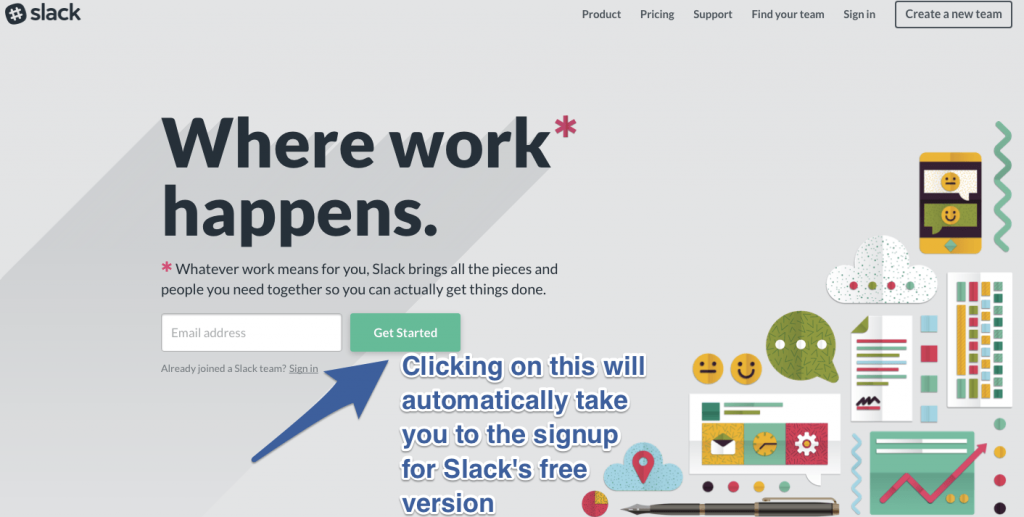
Even if you don’t go through and click that “Get Started” button here or on another page, you won’t find any sort of lead gen elsewhere on the website asking for your name, title, phone, company or website. In other words, Slack doesn’t seem to have any sort of process in place to gather full lead data or contact info (they only ever ask for your email address). Yet another way Slack avoids that salesperson persona.
Now, after I signed up, I kept waiting for some sort of email autoresponder campaign aimed at getting me to convert to a paid user. But yet…there was nothing. Not a single email was sent to me with a mention of upgrading to the paid plan.
Is Slack missing out on conversions by not trying to upsell it’s free users? Maybe. But it’s obviously not bothering them enough to change it. So for now, at least, Slack will remain true to their “not a salesperson” voice.
The third item ties the first and second together: Slack puts customer success at the core of all they do.
Though Slack’s first step with any new customer is an easy onboarding process, that alone is not enough…they also need to keep their customers actually using the product by offering genuine, non-salesy help.
And Slack has no better motivation for this than their innovative “Fair Billing Policy.”

In simple terms, here’s how their policy works: if a Slack user stops using the software for 14 days, Slack will give you your money back through prorated credit.
Slack’s Head of Customer Success explained this himself at the very end of this panel at SaaStock London (29:25 to 30:40).
Slack’s user consumption model forces Slack’s growth to correlate with their customers’ growth, otherwise this happens:

The email Slack send you when you get credit back
This “Fair Billing” model keeps Slack’s whole team ultra-accountable to providing awesome onboarding and a comfortable user experience so they can onboard as many active users as possible.
Sales people can’t just sell an account and then move on.
For this reason, Slack MUST make sure their product is fully integrated into their users’ day-to-day work…or they won’t get paid.
Instead of pushing the customer toward the paid plan, they just set usage limits after a high level of user consumption has taken place. Limits like this:
- Chat history that stops after 10,000 messages
- File storage that stops after 5GB
- App integrations that stop after 10 apps
Slack then uses very strategic in-app messaging (that triggers based on usage limits) to convert freemium users into paid customers, like this:

In-app messages like the one pictured above prompt users to upgrade to a paid plan (but are only shown to the user once Slack has been fully integrated into their day-to-day work). This prompts the customer when they are likely to be most receptive to Slack’s sales message.
Most enterprise software pricing is designed to charge you per user upfront regardless of how many people on your team are actively using the software (for example, if you buy 1,000 seats but only use 100, you still get charged for 1,000).
But as you can see, Slack’s untraditional pricing model is wholly at odds with what most enterprise companies do.
Yet, it’s working. The proof is in the data: Slack has converted 1.25M+ of their 4M+ users into paid users.
9 Key Takeaways from Slack’s Billion-Dollar Success
Slack has some pretty atypical brand marketing techniques that have turned the company into an impressive SaaS powerhouse.
Here are 9 key takeaways:
- Slack built a business app with unprecedented product-market fit. This combined with Butterfield’s connections from Flickr and their freemium business model caused their app to generate viral word-of-mouth brand awareness.
- Slack developed a unique, personable, non-salesy brand personality that is consistent across all channels – from their blog, to their social media, to their ads.
- Slack focused their SEO strategy around branded keywords and integration partner keywords as opposed to content marketing.
- Slack piggybacked off the success and tapped into the audience of other successful companies through integrations.
- Slack used Medium as an outlet for gathering new viewers, keeping customers and followers in-the-know about product updates, and building their brand name.
- Slack built their paid marketing strategy around a small handful of highly-relevant brand keywords and experimented with some more traditional advertising techniques like TV and newspaper ads.
- Slack created fairly minimalist landing pages that easily led prospects to their “Get Started” CTA for a free signup.
- Slack used social media as a way to not only drive traffic, but further their brand voice and get valuable customer interaction.
- Slack nailed their free to paid user conversion rate with an excellent onboarding process, a non-pushy sales method, and a unique “Fair Billing” pricing model based on usage not seats.
Slack gets 100M+ website visitors every month. That’s more than Salesforce, HubSpot, Intercom, Zendesk, Mailchimp, Shopify and every other software company in the world.
They are also the fastest company in the world to get to a $1 billion valuation (1.25 years).
But it’s not all about that.
Slack is a role model for what it takes to build a software company loved by both small businesses and fortune 100 companies alike. If you love what Slack has done and you loved this in-depth analysis, then spread the love by retweeting below:
If you would like to read more in-depth growth studies like this, you should go here.
The post Peek Inside Slack’s Multi-Million Dollar SaaS Growth Strategy appeared first on OpenView Labs.





























































 Take notes… these
Take notes… these 
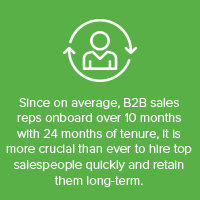
 Having an open vacancy in your sales department for even one-day has a negative impact on your organization. With an
Having an open vacancy in your sales department for even one-day has a negative impact on your organization. With an

 Understanding the negative impacts of open headcount goes beyond top-line revenue and includes sales force morale is critical. Potential decreases in rep productivity and absenteeism due to burnout are directly correlated to sales force understaffing.
Understanding the negative impacts of open headcount goes beyond top-line revenue and includes sales force morale is critical. Potential decreases in rep productivity and absenteeism due to burnout are directly correlated to sales force understaffing. 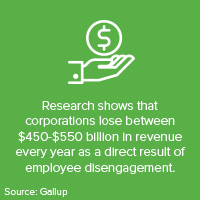
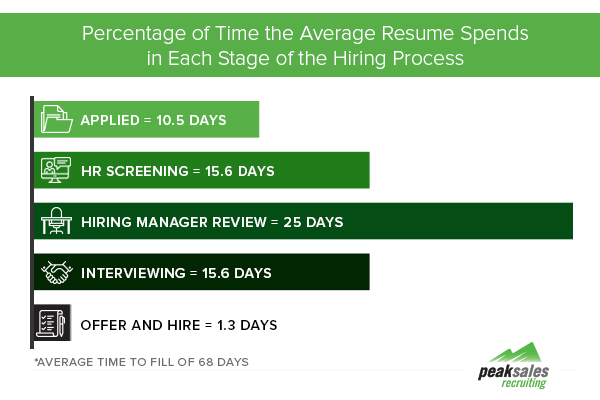

 If it is your Hiring Manager who conducts the candidate review process and selects who will come in for an interview, then list on the Stakeholder List Worksheet that they have two business days to review the resumes and decide who they want to speak with directly.
If it is your Hiring Manager who conducts the candidate review process and selects who will come in for an interview, then list on the Stakeholder List Worksheet that they have two business days to review the resumes and decide who they want to speak with directly. Make sure you are tracking the sources of your hires and the sources of your most successful hires. You can then determine where most of your past sales hiring successes have come from.
Make sure you are tracking the sources of your hires and the sources of your most successful hires. You can then determine where most of your past sales hiring successes have come from.

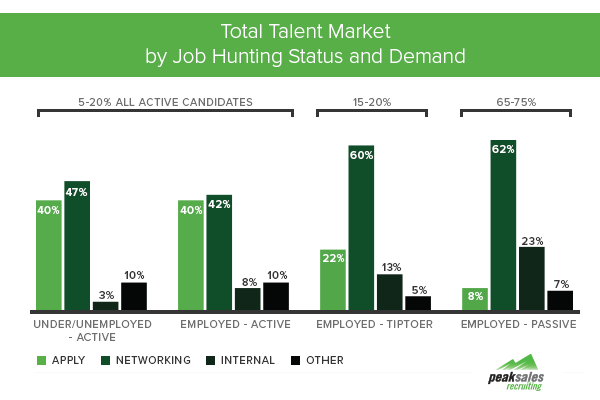
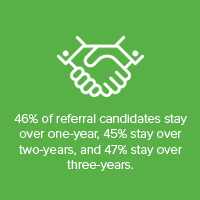 The employee retention rate of referral based candidates is significantly higher than those hired through other channels.
The employee retention rate of referral based candidates is significantly higher than those hired through other channels.  There will always be unexpected departures within the sales industry. With the application process typically taking 10.5 days, it is the organizations who are prepared that successfully recruit their new salespeople faster.
There will always be unexpected departures within the sales industry. With the application process typically taking 10.5 days, it is the organizations who are prepared that successfully recruit their new salespeople faster.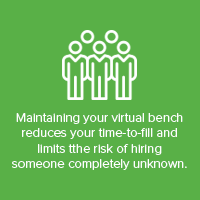 One preparatory measure you should have in place is a
One preparatory measure you should have in place is a  Job descriptions that focus on the benefits of working for your organization will outperform those that focus on role requirements and tasks.
Job descriptions that focus on the benefits of working for your organization will outperform those that focus on role requirements and tasks. 

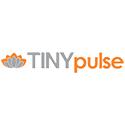
 Skill Scout
Skill Scout Automating your screening process involves using your choice of online software, which you would attach to your job ad. Some of this software could include
Automating your screening process involves using your choice of online software, which you would attach to your job ad. Some of this software could include  The portal provides candidates the opportunity to improve their resume, boost their interview skills, and improve their job search skills. With 98 percent of candidates registering for the portal, it can be used as a pool of candidates to contact for future roles.
The portal provides candidates the opportunity to improve their resume, boost their interview skills, and improve their job search skills. With 98 percent of candidates registering for the portal, it can be used as a pool of candidates to contact for future roles.

 Upon completion, the candidate’s information and answers would be recorded and sent to you accordingly. There are many pieces of software on the market to choose from, such as
Upon completion, the candidate’s information and answers would be recorded and sent to you accordingly. There are many pieces of software on the market to choose from, such as 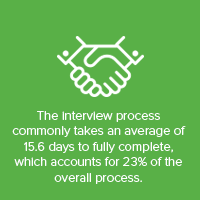

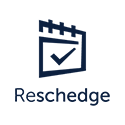

 When you’ve selected your successful candidate and provided them with an offer, you then begin the notice period. This time period commonly happens over the course of
When you’ve selected your successful candidate and provided them with an offer, you then begin the notice period. This time period commonly happens over the course of  Beginning someone’s training while they are in their notice period is a way for you to decrease the amount of onboarding time required. You can provide reading material on your company, your clients, and your industry, so they are well versed upon arrival. If you have online training courses, request they do these courses in advance of their first day*.
Beginning someone’s training while they are in their notice period is a way for you to decrease the amount of onboarding time required. You can provide reading material on your company, your clients, and your industry, so they are well versed upon arrival. If you have online training courses, request they do these courses in advance of their first day*. 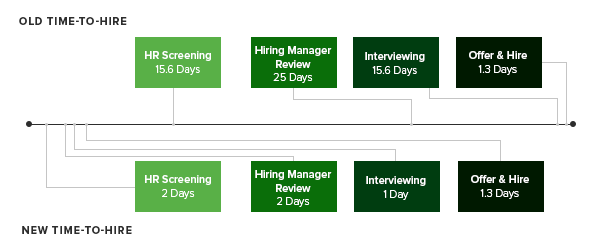



















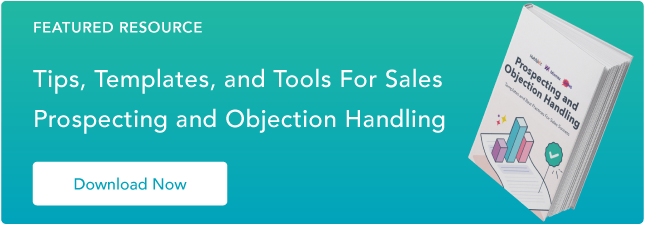











 Take this at face value: Detroit has 50% more venture-backed startups than it did three years ago. This comes from a study (PDF) from the Michigan Venture Capital Association (MVCA) which found there are 35 active venture-backed startups in Detroit. Sure, that’s not a huge number compared to other regions, but the growth is notable. I live in the great state of Michigan and can attest to…
Take this at face value: Detroit has 50% more venture-backed startups than it did three years ago. This comes from a study (PDF) from the Michigan Venture Capital Association (MVCA) which found there are 35 active venture-backed startups in Detroit. Sure, that’s not a huge number compared to other regions, but the growth is notable. I live in the great state of Michigan and can attest to…  There’s something to be said for thorough, extensively researched buyer personas.
There’s something to be said for thorough, extensively researched buyer personas.

-608817-edited.jpg?t=1502746129917&width=730&name=sales-questions-compressor%20(1)-608817-edited.jpg)







































